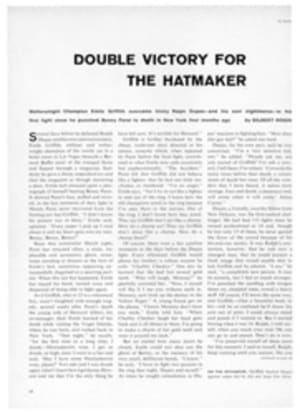
The fire on New York's famous little island
Not far from New York City is a shining, 30-mile-long finger of sand, pointing northeast, called Fire Island. Despite its nearness to the city, it remains remarkably unspoiled, and for a relatively small piece of real estate it is remarkably well known throughout the country (the late Wolcott Gibbs made it the setting for his play Season in the Sun). Fire Island is part of the barrier beach that parallels Long Island for much of the latter's 140-mile, length, serving its big brother as a protective break water against Atlantic storms. It also has several generations of sun-and-sea-seeking New Yorkers; 18 cottage communities, some with exotic names like Kismet, Saltaire and Point O'Woods, have grown up on the island, most of them reachable from the mainland only by ferry—an inconvenience some 35,000 summer residents and visitors gladly put up with.
The summer people love Fire Island, but year by year they find less of it to love, for the sea is encroaching steadily upon it; and last week the island was threatened from another quarter, one that may be even more destructive of the qualities its devotees cherish. Fire Island's Battle of the Atlantic is one of erosion—thousands of tons of the sand of which it is made are being eaten away annually by the sea. The U.S. Army Corps of Engineers some time ago came up with a plan to stop this—a system of jetties built at strategic spots to break the power of the surf and the dredging of Great South Bay behind the island to build up the dunes. All hands agree that this would save the island, and Congress approved the plans two years ago, although the money—$10 million—to carry it out has not yet been appropriated. But the larger threat to Fire Island, one which brought some 1,500 of its devotees out in howling protest last week, is a highway.
Robert Moses, president of the Long Island State Park Commission, has treasured the plan for this highway for 32 years. Creator of Long Island's parkway system and beautiful Jones Beach and mastermind of New York's forthcoming World's Fair, Moses has been peering through the bulrushes on Fire Island recently to see how his highway might fit into the erosion-control plan. As matters have developed, it fits like the last piece of a fateful jigsaw puzzle.
Fire Island has a bridge at its east end, leading to a small park owned by Suffolk County. Across the inlet at its western end, another bridge is abuilding, which by 1964 will lead to a five-mile stretch of beach run by the New York State Park system. All that remains to carry out the Moses plan is to fill the gap between these bridges with a concrete road running up the spine of the island—and, says Moses triumphantly, this road will stabilize the dunes.
Moses contends that the islanders are being selfish in wanting to keep the public out. The islanders retort that the public is welcome—as long as it comes by ferry and leaves its cars on the other side. Moses says his road will provide the residents even more privacy than they now have because access to the beach will be only at designated state-owned areas. The islanders find privacy at this price too expensive in terms of noise and gasoline fumes, and, anyway, they ask, how would anyone get to the beach without crossing the road? Moses says he will build tunnels at convenient intervals under the roads, but the islanders feel this is hardly an answer and point out that in times of heavy seas tunnels may well become funnels to channel water into the inland areas. And finally, what, of the homes displaced, when in some sections the island is barely as wide as the right-of-way?
These were the matters discussed last week at a meeting held at Jones Beach to argue out the Fire Island controversy—and the wind that blew in the 90° heat wave was no hotter than that stirred up by Fire Island's devotees. Said one islander: "If Bob Moses had been around at the time of Genesis he would have paved the Garden of Eden." Said Charles Collingwood, TV commentator and Fire Islander, quoting the late Elmer Davis in a 1938 comment on Moses' already controversial proposal for a road up the island: "Moses would save Fire Island the way Hitler is saving the Sudetenland." Moses, after 24 years, still didn't like the joke; he walked out of the meeting.
Robert Cushman. Murphy, curator emeritus of the American Museum of Natural History, summed up the islanders' case in words that had a meaning far beyond the immediate and. local issue: "Why must we supply traffic arteries to shunt everywhere people who want to sit on their bottoms? Is there no virtue in cherishing something that has to be won by purposeful desire and a little effort?"
Although a National Park Service survey has identified Fire Island as one of the few remaining areas on the Atlantic Coast suitable for designation as a national seashore park, such as the Great Beach of Cape Cod (SI, Sept. 11, 1961), Secretary of the Interior Udall has not yet been moved to suggest that this be done. If it is not, what will have been lost? First and perhaps most important, a place only 50 miles from Times Square where one can do pretty much as he pleases as long as he bothers nobody else. A place to swim, sail, fish, crab or clam. A place where a man—or a woman—can wander down the beach in the black of night shouting at the sea. A place where a person may sit at his ease in the sun and read, knowing that his young children are not crossing a busy highway against heavy traffic.
These values, which may seem only sentimental to the planners and builders, are the values of many men and women who divide their time between islands—Fire and Manhattan. Manhattan is choked almost to death by traffic; Fire is one of the last remaining outposts along the North Atlantic Coast still free of the automobile. In most places it is as beautifully wild as the sea itself—a peaceful anachronism in a hurry-scurry country. The road builders may feel they are working toward the greatest good for the greatest number, but Robert Murphy disputes this theory. He says: "It is high time that our society began to recognize the bench marks [or the waterline] at which the greatest number utterly wipes out the greatest good, once and forever."
ILLUSTRATION
RICHARD ERDOES

